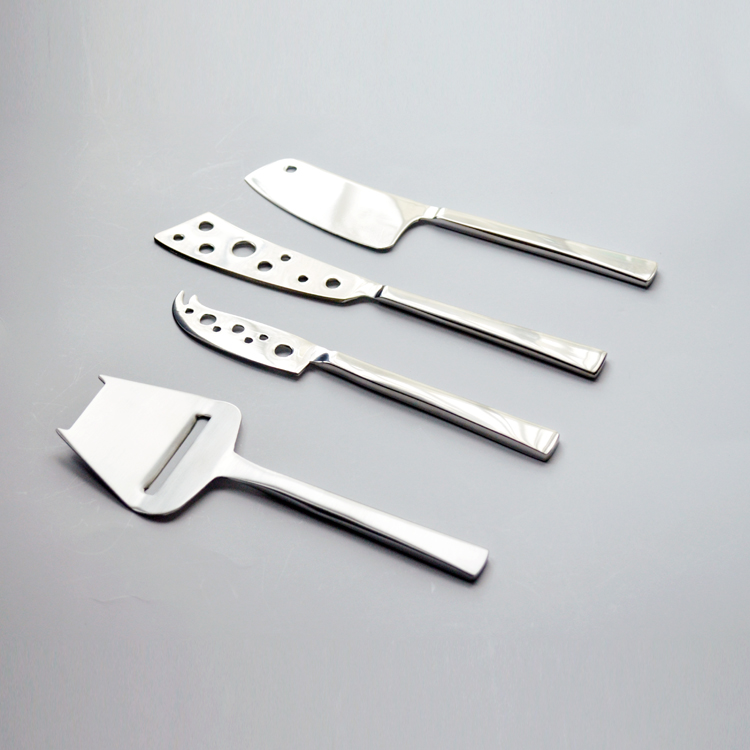Views: 290 Author: Site Editor Publish Time: 2025-11-18 Origin: Site











Content Menu
>> Design Features of a Cheese Cleaver
>> 1. Traditional Cheese Cleaver
>> Step 1: Choose the Right Cheese
>> Step 2: Position the Cheese
>> Step 3: Cut with Confidence
● Caring for Your Cheese Cleaver
● Choosing the Right Cheese Cleaver
>> Material
>> Blade Size
● Popular Cheese Cleaver Brands
● Creative Ways to Use a Cheese Cleaver
A cheese cleaver is a specialized knife designed for cutting hard and semi-hard cheeses. Its wide, flat blade allows for easy slicing and cubing, making it an ideal choice for serving cheese at gatherings or for personal enjoyment. Unlike traditional knives, cheese cleavers are built to handle the density of harder cheeses without bending or breaking.
Cheese cleavers typically feature:
- Wide Blade: The broad surface area allows for efficient cutting and serving.
- Sturdy Handle: A comfortable grip is essential for applying the necessary force when cutting through hard cheeses.
- Durable Material: Most cheese cleavers are made from stainless steel or high-carbon steel, ensuring longevity and sharpness.
While all cheese cleavers serve a similar purpose, there are variations designed for specific types of cheese. Here are some common types:
This is the most common type, featuring a rectangular blade that is perfect for cutting through hard cheeses like cheddar and gouda.
A smaller version of the traditional cleaver, this knife is ideal for cutting smaller blocks of cheese or for use on cheese boards.
This cleaver resembles a small hatchet and is designed for heavy-duty cutting. It is particularly effective for hard cheeses like Parmesan.
Using a cheese cleaver is straightforward, but there are some techniques to ensure you get the best results:
Select a cheese that is suitable for your cleaver. Hard cheeses like Parmigiano-Reggiano or aged cheddar are perfect for a cheese cleaver.
Place the cheese on a stable cutting board. Ensure it is secure to prevent slipping while cutting.
Using a firm grip on the handle, apply even pressure as you slice through the cheese. For larger blocks, you may need to rock the cleaver back and forth to achieve clean cuts.
Once cut, arrange the cheese on a platter with accompaniments like crackers, fruits, and nuts for a delightful cheese board.
To maintain the quality and longevity of your cheese cleaver, follow these care tips:
- Hand Wash Only: Avoid putting your cleaver in the dishwasher. Instead, wash it by hand with warm, soapy water.
- Dry Immediately: After washing, dry the cleaver thoroughly to prevent rusting.
- Sharpen Regularly: Keep the blade sharp for optimal performance. Use a whetstone or a professional sharpening service as needed.
When selecting a cheese cleaver, consider the following factors:
Opt for high-quality stainless steel or carbon steel for durability and sharpness.
Choose a cleaver with a handle that feels comfortable in your hand. Ergonomic designs can reduce fatigue during use.
Consider the size of the cleaver based on your cheese preferences. A larger blade is better for big blocks of cheese, while a smaller one is more versatile for various cheese types.
Several brands are known for their high-quality cheese cleavers. Here are a few to consider:
- Wüsthof: Renowned for their craftsmanship, Wüsthof offers a range of cheese knives, including cleavers.
- Victorinox: Known for their Swiss Army knives, Victorinox also produces excellent cheese cleavers.
- MATTSTONE: This brand specializes in cheese tools and offers a premium cheese cleaver designed for hard cheeses.
Beyond cutting cheese, a cheese cleaver can be used in various culinary applications:
The wide blade is perfect for chopping fresh herbs quickly and efficiently.
Use the cleaver to slice cured meats, making it a versatile tool for charcuterie boards.
The sturdy blade can also be used for cutting vegetables, especially when preparing a cheese and veggie platter.
A cheese cleaver is an indispensable tool for any cheese enthusiast. Its design and functionality make it perfect for cutting a variety of cheeses, enhancing your cheese-tasting experience. By understanding how to use and care for your cleaver, you can enjoy delicious cheese creations for years to come.

1. What types of cheese can I cut with a cheese cleaver?
- Cheese cleavers are best for hard and semi-hard cheeses like cheddar, gouda, and Parmesan.
2. How do I clean my cheese cleaver?
- Hand wash with warm, soapy water and dry immediately to prevent rust.
3. Can I use a cheese cleaver for other foods?
- Yes, cheese cleavers can also chop herbs, slice charcuterie, and prepare vegetables.
4. How often should I sharpen my cheese cleaver?
- Sharpen as needed, depending on usage. A sharp blade is essential for clean cuts.
5. What is the best material for a cheese cleaver?
- High-quality stainless steel or carbon steel is recommended for durability and sharpness.